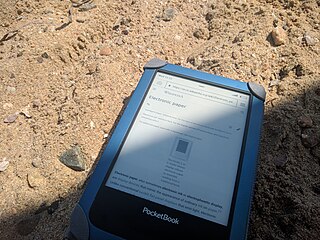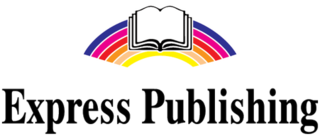Related Research Articles
Portable Document Format (PDF), standardized as ISO 32000, is a file format developed by Adobe in 1993 to present documents, including text formatting and images, in a manner independent of application software, hardware, and operating systems. Based on the PostScript language, each PDF file encapsulates a complete description of a fixed-layout flat document, including the text, fonts, vector graphics, raster images and other information needed to display it.
The Baen Free Library is a digital library of the science fiction and fantasy publishing house Baen Books where 61 e-books as of June 2016 can be downloaded free in a number of formats, without copy protection. It was founded in late 1999 by science fiction writer Eric Flint and publisher Jim Baen to determine whether the availability of books free of charge on the Internet encourages or discourages the sale of their paper books.
Electronic publishing includes the digital publication of e-books, digital magazines, and the development of digital libraries and catalogues. It also includes an editorial aspect, that consists of editing books, journals or magazines that are mostly destined to be read on a screen.

In software design, the look and feel of a graphical user interface comprises aspects of its design, including elements such as colors, shapes, layout, and typefaces, as well as the behavior of dynamic elements such as buttons, boxes, and menus. The term can also refer to aspects of a non-graphical user interface, as well as to aspects of an API – mostly to parts of an API that are not related to its functional properties. The term is used in reference to both software and websites.

Marginalia are marks made in the margins of a book or other document. They may be scribbles, comments, glosses (annotations), critiques, doodles, or illuminations.

Apple Inc. uses a large variety of typefaces in its marketing, operating systems, and industrial design with each product cycle. These change throughout the years with Apple's change of style in their products. This is evident in the design and marketing of the company.

Franklin Electronic Publishers, Incorporated is an American consumer electronics manufacturer based in Burlington, New Jersey, founded in 1981. Since the mid-1980s, it has primarily created and sold hand-held electronic references, such as spelling correctors, dictionaries, translation devices, medical references, and Bibles. It was publicly traded on the American Stock Exchange under the symbol FEP until September 30, 2009, when it merged with Saunders Acquisition Corporation.
The Voyager Company was a pioneer in CD-ROM production in the 1980s and early 1990s. The company published The Criterion Collection, a pioneering home video collection of classic and important contemporary films on LaserDisc. It was founded in 1984 by four partners: Jon Turell, Bill Becker, Aleen Stein, and Robert Stein in Santa Monica, California, and later moved to New York City. The firm took its name from the Voyager space craft.
An annotated bibliography is a bibliography that gives a summary of each of the entries. The purpose of annotations is to provide the reader with a summary and an evaluation of each source. Each summary should be a concise exposition of the source's central idea(s) and give the reader a general idea of the source's content.

P22 Type Foundry is a digital type foundry and letterpress printing studio based in Rochester, New York. The company was created in 1994 in Buffalo, New York by co-founders Richard Kegler and Carima El-Behairy. The company is best known for its type designs, which have appeared in films and on commercial products. The P22 Type Foundry retail font collection specializes in historical letterforms inspired by art, history, and science that otherwise have never been available previously in digital form. P22 works with museums and foundations to ensure the development of accurate historical typefaces, and with private clients to create custom bespoke fonts.

The Sony Reader was a line of e-book readers manufactured by Sony, who produced the first commercial E Ink e-reader with the Sony Librie in 2004. It used an electronic paper display developed by E Ink Corporation, was viewable in direct sunlight, required no power to maintain a static image, and was usable in portrait or landscape orientation.
The following is a comparison of e-book formats used to create and publish e-books.

EPUB is an e-book file format that uses the ".epub" file extension. The term is short for electronic publication and is sometimes styled ePub. EPUB is supported by many e-readers, and compatible software is available for most smartphones, tablets, and computers. EPUB is a technical standard published by the International Digital Publishing Forum (IDPF). It became an official standard of the IDPF in September 2007, superseding the older Open eBook standard.

The Newton is a series of personal digital assistants (PDAs) developed and marketed by Apple Computer, Inc. An early device in the PDA category, it was the first to feature handwriting recognition. Apple started developing the platform in 1987 and shipped the first devices in 1993. Production officially ended on February 27, 1998. Newton devices ran on a proprietary operating system, Newton OS; examples include Apple's MessagePad series and the eMate 300, and other companies also released devices running on Newton OS. Most Newton devices were based on the ARM 610 RISC processor and all featured handwriting-based input.

An electronic book, also known as an e-book or eBook, is a book publication made available in digital form, consisting of text, images, or both, readable on the flat-panel display of computers or other electronic devices. Although sometimes defined as "an electronic version of a printed book", some e-books exist without a printed equivalent. E-books can be read on dedicated e-reader devices, but also on any computer device that features a controllable viewing screen, including desktop computers, laptops, tablets and smartphones.

Apple Books is an e-book reading and store application by Apple Inc. for its iOS and macOS operating systems and devices. It was announced, under the name iBooks, in conjunction with the iPad on January 27, 2010, and was released for the iPhone and iPod Touch in mid-2010, as part of the iOS 4 update. Initially, iBooks was not pre-loaded onto iOS devices, but users could install it free of charge from the iTunes App Store. With the release of iOS 8, it became an integrated app. On June 10, 2013, at the Apple Worldwide Developers Conference, Craig Federighi announced that iBooks would also be provided with OS X Mavericks in fall 2013.

Text annotation is the practice and the result of adding a note or gloss to a text, which may include highlights or underlining, comments, footnotes, tags, and links. Text annotations can include notes written for a reader's private purposes, as well as shared annotations written for the purposes of collaborative writing and editing, commentary, or social reading and sharing. In some fields, text annotation is comparable to metadata insofar as it is added post hoc and provides information about a text without fundamentally altering that original text. Text annotations are sometimes referred to as marginalia, though some reserve this term specifically for hand-written notes made in the margins of books or manuscripts. Annotations are extremely useful and help to develop knowledge of English literature.
LEAD Technologies Inc. is a privately held software company headquartered in Charlotte, North Carolina, USA. LEAD develops, markets and supports a line of imaging toolkits called LEADTOOLS.

Express Publishing is an independent UK based publishing house with its headquarters in Berkshire. The company was founded in 1988 and it specializes in English language learning and teaching and ELT educational materials. Express Publishing has established a presence in more than 90 countries, in many of them holding ministerial approvals.

Florian Brody is an Austrian/American digital media creator, inventor, writer, public speaker, academic, and global business consultant. He is best known for his contributions to the invention and development of Expanded Books, an early form of E-books, at the Voyager Company, and for his writings and public speaking about digital media innovation and marketing, including TEDx talks in Austria, as well as his 1999 essay "The Medium is the Memory," originally published in MIT Press's The Digital Dialectic: New Essays on New Media, edited by Peter Lunenfeld. Brody serves as principal at The Halo Agency, which supports European start-up businesses looking to enter the US market.
References
- 1 2 3 4 Cohen, Michael (2013-12-19). "Scotched: Fair thoughts and happy hours did not attend upon an early enhanced-book adaptation of Macbeth". The Magazine. Seattle, WA: Aperiodical LLC (32). Retrieved 2015-06-07.
- 1 2 Visel, Dan (2010-07-23). "Mao, King Kong, and the Future of the Book". Triple Canopy. New York, NY (9). Retrieved 2015-07-06.
- ↑ Langberg, Mike (1992-02-24). "Firms seek to marry books, computers". The Baltimore Sun. Retrieved 2015-06-29.
- 1 2 3 Buwalda, Minne (1994). "Voyager: The expanded Book Toolkit, Voyager Company". www.mediamatic.net. Retrieved 2015-07-06.
- ↑ Haglund, David (2012-05-29). "Did You See This? The History of the Book in Two Minutes". www.slate.com. Retrieved 2015-07-06.
- ↑ "The Voyager Company Develops "Expanded Books": Electronic Books that Would Attempt to be Both Familiar and Useful to Regular Book Readers : History of Information". www.historyofinformation.com. Retrieved 2020-05-20.
- 1 2 Martin, Jeff (2010). "Voyager Company CD-ROMs: Production History and Preservation Challenges of Commercial Interactive Media" (PDF). Electronic Arts Intermix. Retrieved 2015-07-01.